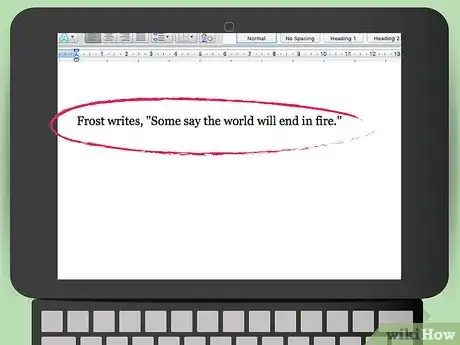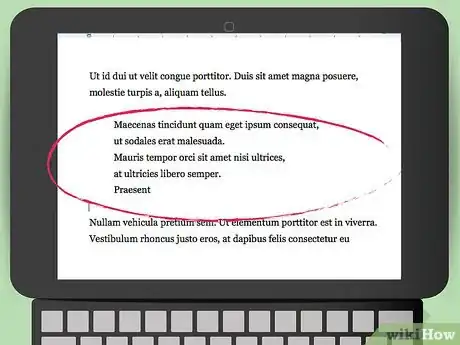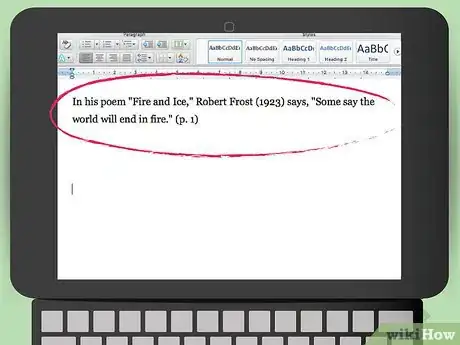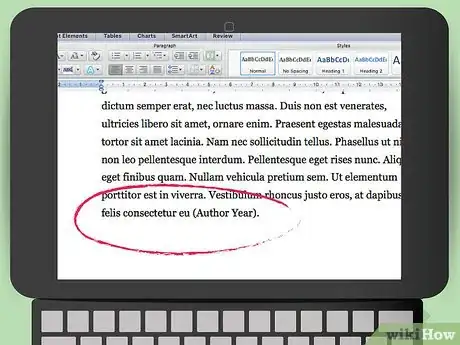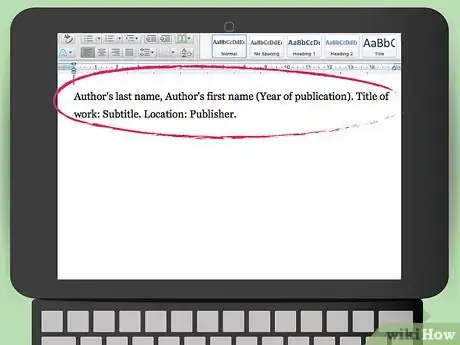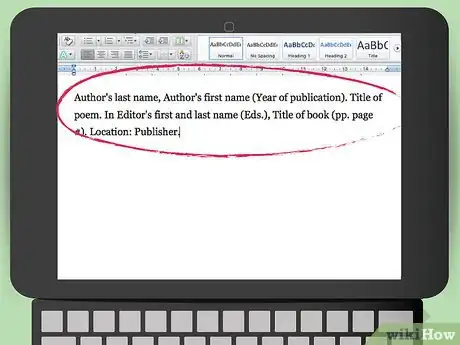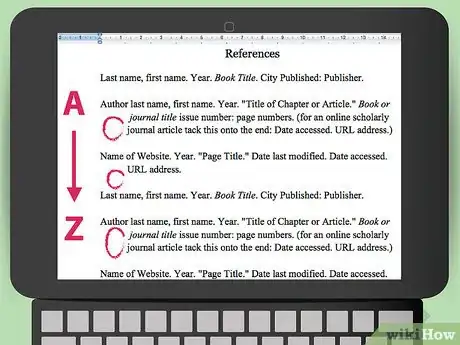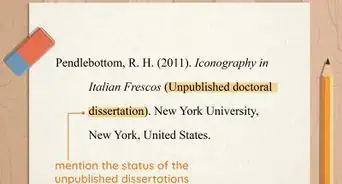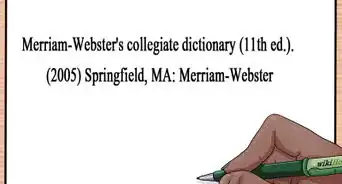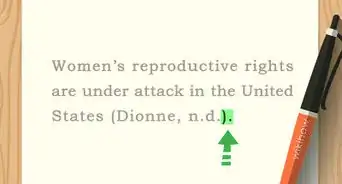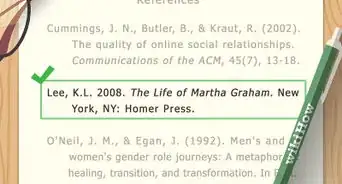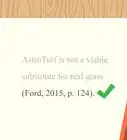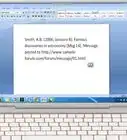This article was co-authored by Michelle Golden, PhD. Michelle Golden is an English teacher in Athens, Georgia. She received her MA in Language Arts Teacher Education in 2008 and received her PhD in English from Georgia State University in 2015.
This article has been viewed 155,356 times.
The American Psychological Association (APA) style guide is very popular, especially in the social sciences. If you need to write a paper in APA style, there are a lot of different formatting rules to consider. Citing sources, such as poems, can be one of the most confusing things, but if you follow a few simple rules, you'll have perfectly formatted citations.
Steps
Quoting a Poem in Your Essay
-
1Use quotation marks with short quotes. If you want to quote fewer than 40 words of a poem in your essay, the quote should be enclosed in quotation marks. You do not need to start a new line to set off the quote.[1]
- For example, introduce a short quote like this. Frost writes, "Some say the world will end in fire."
-
2Indicate line breaks. If you quote more than one line of poetry within the main body of your essay, you must indicate where the line breaks are. Do this by including a forward slash (/) between each line.[2]
- For example, cite two line of a poem like this: "Some say the world will end end fire, / Some say in ice."
Advertisement -
3Use block quotations for longer quotes. If you wish to quote more than 40 words of a poem, you should use block quotation formatting, which begins on a new line and is indented 1⁄2 inch (1.3 cm) from your left margin.[3]
- You should not use quotation marks with block quotes. It is not necessary because the indentation signifies that it is a quote.
- Be sure to maintain the same double spacing that you have in the rest of your paper.
Using Proper In-Text Citations
-
1Include the author's name, the year, and the page number. Whenever you include a quote from a poem, you must accompany it with an in-text citation that refers the reader to the correct entry in your works cited. This citation should always include the author's last name, the year of publication, and the page number the quote can be found on preceded by "p.".[4]
- If you mention the author's name in the sentence that introduces the quote, include the year in parentheses after the author's name, and the page number in parentheses after the end of quote. For example: In his poem "Fire and Ice," Robert Frost (1923) says, "Some say the world will end in fire." (p. 1)
- If you don't include the author's name in the sentence that introduces the quote, provide all three pieces of information, separated by commas, in parentheses after the end of the quote. For example: "Some say the world will end in fire." (Frost, 1923, p. 1)
- Parenthetical citations should always come after the punctuation of the preceding sentence.
-
2Don't forget to cite indirect references. You need to cite a poem (or any other source) whenever you refer to it, even if you do not provide a quote. Follow the same guidelines for parenthetical citations whenever you refer to your source.[5]
- If you are not referring to one specific page of the poem, you may omit the page number from your parenthetical citation, although you are encouraged to provide a page number whenever possible.
-
3Properly format titles. Be sure to use proper capitalization and typeface when you mention the title of a poem or other source. Note that the formatting rules are different for the body of your essay and the works cited. In the body of your essay, follow these rules:[6]
- Capitalize all major words in the title of any work.
- Put quotation marks around the titles of shorter works (such as most poems).
- Italicize or underline the title of longer works (such as anthologies).
Citing a Poem in Your Works Cited
-
1Cite an entire book. If you are citing a book-length poem, use citation guidelines provided for print books. Make sure your punctuation and capitalization match the example:[7]
- Author's last name, Author's first name (Year of publication). Title of work: Subtitle. Location: Publisher.
-
2Cite a poem in an anthology. Many times, shorter poems are found within larger collections or anthologies. If this is the case for your poem, use the APA's citation guidelines for articles and chapters within an edited book. Follow this example, making sure to include "In" before the editor's name and "pp." before the page numbers:[8]
- Author's last name, Author's first name (Year of publication). Title of poem. In Editor's first and last name (Eds.), Title of book (pp. page #). Location: Publisher.
-
3Tailor the guidelines for your book. All sources are slightly different, so you might have to make slight variations to each of your citations to accommodate them. If you are not sure how to handle a specific piece of information, ask your teacher for advice.
- In general, if your source does not provide a specific piece of information, it is okay to omit it from the citation.
- Note that when citing multiple pages you should notate it with "pp." instead of "p."
-
4Include extra information for electronic sources. If you need to cite a poem that you found online, cite it as you would a print source, including all of the information that the website's publisher makes available. In addition you should include information that will help your reader find your digital source.[9]
- For a website, include the words "Retrieved from" followed by the full web address at the end of your citation.
- For an e-book, include the e-book format in square brackets directly after the title of the book (for example, [Kindle DX version]). Then include the words "Available from" followed by the website from which you retrieved the e-book at the end of your citation.
-
5Format your works cited. Once you have compiled all of the information you need for your citations, you need to make sure that your works cited page is formatted and organized correctly. Remember that the rules for capitalization are different than those that you must follow when writing in the body of your essay.[10]
- Capitalize only the first word of the title of a book, not every word.
- Do not surround the title of a poem with quotation marks.
- Use the title References at the top of your page.
- Alphabetize your entries by the author's last name. If you have more than one source by the same author, use the date of publication to list them chronologically.
- The first line of each citation should not be indented, but all additional lines should be indented 1⁄2 inch (1.3 cm) (two spaces) from the left margin.
- Maintain the same double spacing you have throughout the rest of your paper.
- If you are providing annotations (descriptions of your sources), provide them directly beneath your citation, indented two spaces further than the second line of your citation.
Community Q&A
-
QuestionIf I'm using quotes from multiple poems in a book of poems, do I cite the book once or each individual poem that I use? For an APA style paper.
 Community AnswerCite each poem individually, but include the source text in each entry for these in the bibliography.
Community AnswerCite each poem individually, but include the source text in each entry for these in the bibliography.
Warnings
- Be sure to cite all of the sources that you quote, paraphrase, or even refer to when writing a paper so that you avoid all appearances of plagiarism.⧼thumbs_response⧽
- Don’t forget that you will also have to compose your entire essay or paper according to the APA style. This includes using the APA rules regarding line and paragraph spacing, typeface, margins, etc.⧼thumbs_response⧽
References
- ↑ https://libguides.swansea.ac.uk/APA7Referencing/Poetry
- ↑ https://owl.purdue.edu/owl/general_writing/punctuation/quotation_marks/quotation_marks_with_fiction.html
- ↑ https://owl.purdue.edu/owl/general_writing/punctuation/quotation_marks/quotation_marks_with_fiction.html
- ↑ https://libguides.swansea.ac.uk/APA7Referencing/Poetry
- ↑ https://owl.purdue.edu/owl/research_and_citation/apa_style/apa_formatting_and_style_guide/in_text_citations_author_authors.html
- ↑ https://owl.purdue.edu/owl/research_and_citation/apa_style/apa_formatting_and_style_guide/in_text_citations_author_authors.html
- ↑ https://libguides.swansea.ac.uk/APA7Referencing/Poetry
- ↑ https://penandthepad.com/cite-poem-apa-format-5072453.html
- ↑ https://penandthepad.com/cite-poem-apa-format-5072453.html
About This Article
If you want to cite a poem using the APA style, include your quote from a poem in quotation marks if it's less than 40 words, and use forward slashes to indicate line breaks. To cite a longer passage, begin the quote on a new line and indent it to create a block quotation. For your in-text citation, include the author's name, year of publication, and page number, preceded by the letter "p." When it comes to the title, capitalize all major words, place short titles in quotes, and italicize longer titles. To learn how to include your citation in the works cited section of your essay, keep reading!
